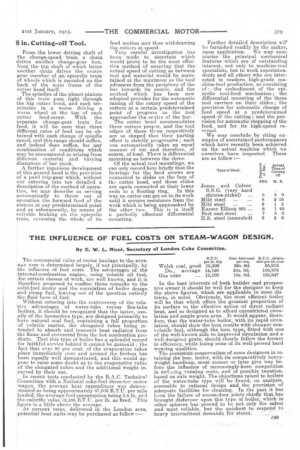THE INFLUENCE OF FUEL COSTS ON STEAM-WAGON DESIGN.
Page 9

If you've noticed an error in this article please click here to report it so we can fix it.
By E. W. L. Nicol, Secretary of London Coke Committee.
The commercial value of motor haulage to the average user is determined largely-, if not principally, by the influeuce of fuel costs. 'The advantages of the internal-combustion engine, using volatile oil fuel, for certain classes of work, are well known, and it is therefore proposed to confine these remarks to the solid-fuel motor and the correlation of boiler design and cheap fuel, leaving out of the question entirely the fluid form of fuel.
Without entering into the controversy of the relative advantages of water-tube versus fire-tube boilers, it should be recognized that the latter, usually of the locomotive type, are designed primarily to -burn natural coal fuel, containing a full proportion of volatile matter, the elongated tubes being intended to absorb and transmit heat radiated from the flame and convected from the hot combustion pro-ducts. That this type of boiler has a splendid record for faithful service behind it cannot be gainsaid the fact that over 90 per cent, of the evaporation -Cakes place immediately over and around the firebox has been equally well demonstrated, and thiswould appear to raise some doubt as to the evaporative value of the elongated tubes and the additional weight incurred by their use.
In recent tests conducted by the R.A.C. Technical Committee with a National coke-fuel three-ton motor wagon, the average heat expenditure was demonstrated as being approximately 47,000 B.T.U. per mile loaded, the average fuel consumption being 3.8 lb. and the calorific value 12,468 B.T.U. per lb. as fired. This .figure is a little above the average. At current rates, delivered in the London area, potential heat units may be purchased as follow :— B.T.II. Coat delit,exed &TAT. Main
per lb. dry. per ton. able per Id. cost
Welsh coal, good 15,200 29s, Gd. 95,912
Do., average 14,140 24s. Od. 108,878 Gas coke ... 13,100 18s. Od. 135,847
In the bast interests of both builder and prospective owner it should be well for the designer to keep the above figures; which are applicable to most districts, in mind. Obviously, the most efficient boiler will be that which offers the greatest proportion of its surface to the effective action of direct radiant heat, and so designed as to afford unrestricted circulation and ample grate area. It would appear, therefore, that the water-tube boiler, with its rapid circulation, should show the best results with cheaper nonvolatile fuel, although the loco. type, fitted with one of the well-known aids to improved circulation and a well-designed grate, should closely follow the former in efficiency, while losing none of its well-proved hard wearing qualities. The persistent conservatism of some designers in retaining the loco, boiler, with its comparatively heavyweight handicap, must sooner or later give way before the influence of increasingly-keen competition in reieeind running costs, and of possible taxation, based on axle weight. The objections raised to boilers of the water-tube type will be found, on analysis, amenable to rational design and the provision of adequate facilities for cleaning, in the past it has been the failure of access-door joints chiefly that has brought disfavour upon this type of boiler, which in other spheres has proved to be not only the safest and most reliable, but the quickest to respond to heavy intermittent demands for steam.


















